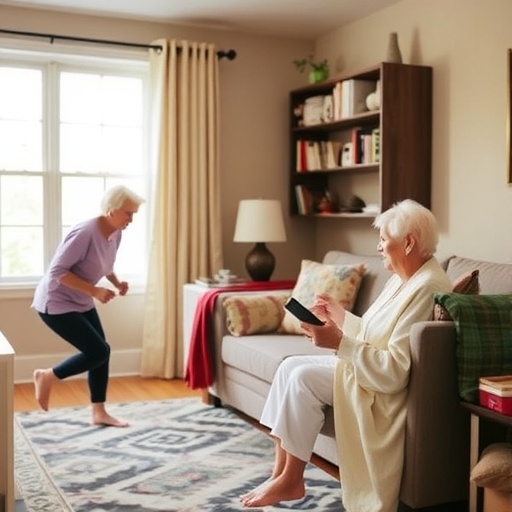In the realm of gerontology and public health, understanding how living environments influence physical activity among older adults has become increasingly vital. Recent findings suggest a compelling link between housing types, home conditions, and levels of exercise among senior citizens. A rising concern within this demographic is the struggle to stay physically active as age-related challenges mount, and exploring the nuances of their living situations offers profound insights into potential interventions.
The research led by Feng Z. sheds light on how different housing types, ranging from independent living facilities to co-housing setups, significantly affect the physical engagement of older adults. Housing is not just a shelter; it creates a primary framework within which seniors navigate their day-to-day lives. Those who reside in amenable housing conditions tend to have better access to exercise opportunities, which remain crucial for maintaining physical health.
Moreover, home conditions feature prominently in this intricate equation. Factors such as safety, accessibility, and surrounding amenities play pivotal roles in whether older adults can successfully integrate physical activity into their routines. For example, homes with lack of nearby parks or recreational facilities may act as barriers, significantly diminishing the likelihood of consistent engagement in exercise. The study highlights that even the most well-meaning intention to remain active can be thwarted by impractical living conditions.
One particularly striking aspect of Feng’s research is the emphasis on social factors entwined with physical activity levels. The notion of community within various housing types appears to positively influence motivation levels among older adults. Those who live in settings that promote social interactions and mindful engagement are more likely to adhere to active lifestyles. Social dynamics can often provide the encouragement needed to overcome inertia, fostering environments that are conducive to physical movement.
As populations continue to age, creating conducive living conditions becomes more pertinent. There’s an urgent call for urban planners and policymakers to rethink housing designs that prioritize accessibility and stimulation. A shift towards more inclusive planning could address these multifaceted needs while simultaneously enhancing public health initiatives focused on senior fitness. Ultimately, adapting our urban landscapes to accommodate older adults will not only foster physical health but also promote improved mental wellness.
The study’s comprehensive analysis of activity levels among older adults across varied housing types reveals a critical gap in understanding the environmental factors influencing health. The discrepancies between different living situations underscore the necessity for tailored approaches to senior health strategies. Older adults living in homes with steeper staircases or with poor lighting often find themselves facing heightened risks of falls, which can deter physical activity. It’s imperative to address these environmental barriers head-on.
Engaging older adults in a dialogue about their living preferences could empower them in making informed decisions about their housing choices. This concept aligns with the broader discourse on aging in place, which advocates for enabling seniors to maintain independence in their chosen communities. Encouraging discussions around housing modifications or adaptations can lead to tailored solutions, improving accessibility and enhancing opportunities for engagement.
With the rise of technology, smart home developments present innovative solutions to enhance safety and accessibility. Solutions such as automatic lighting, adjustable furniture, and monitoring systems can create supportive environments for older adults. Integrating technology into these housing environments may play a vital role in allowing seniors to remain active and socially connected, fostering an overall enhanced quality of life.
The implications of these research findings extend to how communities can rally resources to effectively support their aging populations. Establishing local partnerships between health professionals, community organizations, and housing developers could elucidate actionable strategies. This collaborative approach may substantially enhance the reach and effectiveness of initiatives designed to promote physical activity among older adults.
Education about the importance of physical activity among older populations must move beyond simple awareness campaigns. There’s a need for structured interventions that integrate informative resources within the communities where these seniors reside. Informative sessions on the benefits of consistency in physical activity, led by health professionals, can empower older citizens to prioritize exercise alongside housing adaptations.
Understanding the variables influencing physical activity is just the first step. Beyond research and awareness, implementing change requires commitment from various sectors of society. Policymakers, urban developers, and community organizations must coalesce around a shared vision that prioritizes the well-being of older adults. By translating research into practice, we can effectively address the unique needs of those who have contributed so much throughout their lives.
In conclusion, the associations between housing types, conditions, and levels of physical activity among older adults underscore the richness of this research. Engaging with these findings can prompt much-needed discussions and actions within our communities, fostering environments that support active aging. As studies like Feng’s demonstrate the complex interplay between health, environment, and social dynamics, they illuminate pathways for enhancing quality of life for older adults in our ever-evolving societies.
Understanding how our living conditions impact daily exercise habits can pivot how we design policies and communities for future generations. The extensive implications of Feng’s research could ignite wider movements towards more inclusive and thoughtful housing strategies tailored for older populations, leading not only to healthier individuals but thriving communities.
Ultimately, the goal endures: to ensure older adults can lead empowered and physically active lives, shaped by supportive environments that encourage movement, connectivity, and community engagement. As we reflect on the implications of this research, let us advocate for a future where all seniors have the opportunity and means to flourish in their golden years.
Subject of Research: The relationship between housing type and home conditions with exercise and physical activity among older adults.
Article Title: Associations between housing type and home conditions with exercise and physical activity among older adults.
Article References:
Feng, Z. Associations between housing type and home conditions with exercise and physical activity among older adults.
BMC Geriatr 25, 921 (2025). https://doi.org/10.1186/s12877-025-06619-9
Image Credits: AI Generated
DOI: https://doi.org/10.1186/s12877-025-06619-9
Keywords: Physical activity, older adults, housing, community engagement, health initiatives, urban planning.




